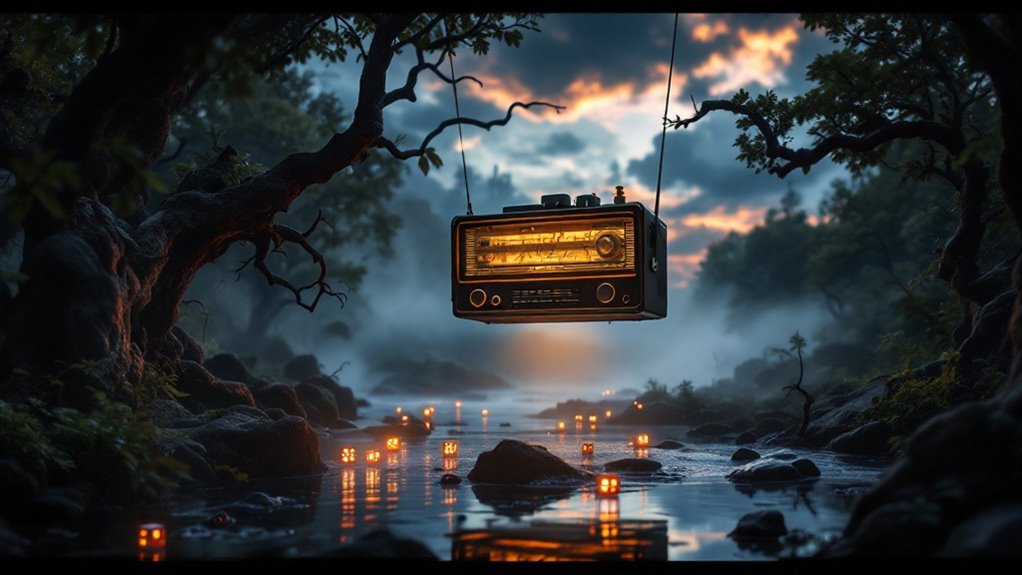David Gilmour's *Luck and Strange* weaves existential grit into lyrics where time gnaws at life's fleeting glow, mirrored by guitar solos that bend like weary sighs. You'll find wartime nostalgia clashing with modern dread, cosmic sunsets framing grandkids' laughter, and raw questions about what lingers when we're dust. Gilmour's minor pentatonic aches balance despair and hope—no cheery answers here, just a haunting nudge to sit with life's beautiful impermanence. Curious how mortality strums these chords? There's more where that came from.
Key Takeaways
- Lyrics explore existential dread and acceptance of mortality through metaphors of time, legacy, and life's fragile beauty.
- Gilmour's guitar solos mirror lyrical themes of vulnerability via bending techniques, minor pentatonic scales, and restrained melodic phrasing.
- Post-WWII nostalgia contrasts modern anxieties, critiquing human hubris with allusions to King Canute and Nabokovian time motifs.
- Intergenerational collaboration emphasizes aging, legacy, and cyclical renewal through familial ties and sun symbolism.
- Ambiguous lyrics balance despair with hope, inviting personal interpretations of transience and human connection.
Emotional Depth of Lyrics
Key Phrases & Imagery
- "How will we part / Will I hold your hand, or you be left holding mine?": Uncertainty about mortality and roles in final moments, evoking vulnerability and fear of abandonment.
- "Darling, turn back the clock, Give me time, make it stop": Desperation to defy aging, emphasizing powerlessness against time's passage.
- "A Single Spark between two eternities": Life framed as transient yet luminous, juxtaposing insignificance against fleeting beauty.
- "It was a fine time to be born, de-mob happy Street": Nostalgia for post-war optimism, contrasting with present disquiet.
Recurring Themes
- Temporal Duality: Past idealism vs. present fragility ("one-off peaceful golden age" vs. uncertainty). This duality mirrors the introspective themes explored in The Division Bell, where Gilmour reflects on the band's journey and the passage of time with a mix of nostalgia and acceptance.
- Intergenerational Bonds: Familial connections (children, grandchildren, Romany Gilmour's vocals) underscore legacy's emotional weight. This theme is further enriched by Charlie Gilmour's lyrical contributions to the track "Scattered," which delve into fragmented memories and the persistence of heritage across generations.
- Existential Liminality: Life as a transient "space between two points," blending cosmic and intimate scales.
Symbols & Metaphors
- Hands: Symbolize connection and separation, reflecting anxieties around mortality and caregiving roles.
- Clock/Time: Represents inevitability and longing; a force both oppressive and cherished.
- Free Milk / Post-War Imagery: Emblems of security and simplicity, contrasting with modern existential ambiguity.
Interpretations
- Longing for Control: Pleas to "turn back the clock" suggest a struggle to reconcile acceptance with defiance of aging.
- Legacy as Continuity: Children and grandchildren symbolize hope beyond individual mortality, anchoring meaning in familial bonds.
- Ecstasy Amid Transience: The "spark" metaphor invites dual readings—life as fragile yet radiant, despair tempered by wonder.
Ambiguity & Open-Endedness
- Parting Dynamics: Uncertainty over who "holds whose hand" leaves roles (caregiver vs. dependent) unresolved, mirroring universal fears of loss.
- Golden Age Subjectivity: The "one-off peaceful" era may critique nostalgia's selectivity, questioning whether such stability ever truly existed.
- "Single Spark" Duality: Open to interpretation as despair (life's brevity) or awe (its intensity), reflecting the tension between resignation and reverence.
Guitar Solo Techniques
David Gilmour's guitar solos function as lyrical extensions of his songs' emotional narratives, blending technical mastery with deliberate restraint. His bending techniques—two-tone bends, pre-bends, and half-step microtonal shifts—act as sonic metaphors for vulnerability and introspection, mirroring lyrical themes of longing or existential questioning.
The slow tempo and spacious rhythmic phrasing allow notes to linger, creating a reflective atmosphere that parallels vocals often suspended in melancholy. Gilmour's use of minor pentatonic scales and Dorian modal inflections, frequently punctuated by doublestops played with first or third fingers across string pairs, establishes a somber yet hopeful duality, while ambient effects like delay and reverb evoke vastness, sonically illustrating concepts of isolation or cosmic wonder.
Instrumentally, his solos emerge from layered arrangements (keyboard pads, steady bass grooves) as a voice distinct yet harmonically aligned, engaging in call-and-response with the vocals to deepen narrative complexity. Gilmour further enriches his solos with the rake technique, muting adjacent strings during aggressive strums to create percussive emphasis before resolving into sustained melodic bends.
By prioritizing melodic clarity over virtuosity, his solos become a bridge between lyrical content and subconscious emotion, transforming abstract ideas—time, loss, transcendence—into visceral, wordless storytelling.
The controlled build of intensity (via dynamics and bending vibrato) mirrors lyrical climaxes, ensuring the instrument's "voice" resonates as profoundly as the words it supports.
Historical Inspirations Explored

Historical Context in "Luck and Strange"
The title track situates itself in the post-WWII "golden age," framing the period as a fleeting moment of optimism for baby boomers, juxtaposed against modern uncertainties like climate change and political fragmentation. This duality reflects Gilmour's broader thematic focus on cyclical history, echoing Pink Floyd's exploration of societal disillusionment (e.g., *The Wall*'s postwar trauma) while shifting to a more personal, generational perspective. Gilmour's own experience of replacing Syd Barrett during Pink Floyd's formative years mirrors the album's juxtaposition of transient optimism with underlying instability.
Literary and Mythological References
Lyrics draw heavily from Nabokov's *Speak, Memory*, particularly its meditation on time and impermanence. The phrase "two eternities" in "A Single Spark" mirrors Nabokov's concept of life as a brief spark between pre-birth and post-death voids.
The allusion to King Canute in "Scattered" underscores themes of human hubris and powerlessness against natural forces, paralleling Gilmour's critique of modern leaders failing to address existential crises.
Musical Continuity and Legacy
The cover of Montgolfier Brothers' "Between Two Points" bridges past and present, with Gilmour's admiration for the original underscoring his affinity for melancholic, atmospheric textures reminiscent of Pink Floyd's *Wish You Were Here* era.
Richard Wright's archived keyboard recordings further root the album in the band's sonic legacy, while contemporary production modernizes these elements, reflecting the tension between nostalgia and progress.
Intergenerational Collaboration
Family contributions—Polly Samson's co-writing, Charlie Gilmour's lyrics, and Romany Gilmour's harp/vocals—mirror the album's themes of generational continuity. This collaboration underscores Gilmour's reflection on aging and legacy, contrasting the postwar idealism of his youth with the complexities inherited by younger generations.
Broader Discographic Resonance
*Luck and Strange* extends Pink Floyd's tradition of blending existential inquiry with social critique, akin to *Dark Side of the Moon*'s exploration of time and mortality.
However, it diverges by focusing on intimate, familial narratives rather than abstract universality, marking a evolution in Gilmour's lyrical focus from collective angst to personal and generational retrospection.
Existential Metaphors Explored
The song's existential metaphors have been interpreted through multiple lenses. These metaphorical explorations are further enriched by the lyrical contributions of Polly Samson, Gilmour's longtime collaborator, whose poetic sensibility has shaped the band's narrative direction since the mid-90s. Critics highlight the recurring sun imagery as emblematic of life's cyclical impermanence, with its setting symbolizing mortality and its rising evoking fleeting renewal.
Others analyze celestial metaphors—stars, galaxies—as underscoring human fragility against cosmic vastness, framing existence as both insignificant and paradoxically wondrous. The motif of "hands holding" is debated as dualistic: a tender symbol of connection battling temporal decay or a fragile anchor against existential void.
Natural elements like earth and seasons are read as grounding metaphors for acceptance of life's transient, cyclical rhythms. This interplay of existential themes echoes literary critiques of vanity found in works like Oscar Wilde's *The Picture of Dorian Gray*, where the illusion of eternal youth is revealed as a hollow pursuit. My interpretation synthesizes these layers: the lyrics use cosmic and natural imagery to juxtapose individual impermanence with universal continuity, while the music's melancholic yet soaring tones mirror this tension.
The sun's duality—setting (loss) and rising (legacy)—reflects Gilmour's meditation on mortality as both personal end and collective rebirth. The recurring hand imagery, paired with sparse instrumentation during reflective verses, amplifies the vulnerability of human bonds as transient yet defining.
Ultimately, the song resists singular meaning. Its power lies in balancing stark existential dread with quiet reverence for shared human transience, inviting listeners to project their own struggles with time, connection, and legacy onto its poetic ambiguity.
Frequently Asked Questions
What Studio Equipment Was Used for "Luck and Strange"?
You ignite sonic alchemy at Medina Studio, wielding Gilmour's Black Strat through vintage Fender amps and a snarling Electro-Harmonix Big Muff. Command the Yamaha RA-200's swirling vortex, cutting tracks with buttery 1956 Les Paul growls.
Did Gilmour Collaborate With Other Lyricists for This Song?
You'll find Gilmour collaborated primarily with Polly Samson—his wife and longtime lyricist—on "Luck and Strange." Their son Charlie co-wrote lyrics, blending generational perspectives into the album's exploration of mortality through intimate family artistry.
How Does the Track Length Compare to His Other Works?
You notice tracks dominate with unapologetic expanses—averaging 5.5 minutes, surpassing 1978's solo work. Barn Jam's 14-minute sprawl and multi-part structures command attention, echoing *On an Island*'s ambition but stretching further.
Are There Live Performance Differences in the Song's Structure?
You'll hear extended guitar solos added to the outro and improvised instrumental breaks between verses. Backing vocals dominate more, orchestral layers amplify crescendos, and intros stretch beyond studio cuts, creating dynamic shifts that command the arena's energy.
What Inspired the Song's Title Phrasing "Luck and Strange"?
Ever wrestled fate's capricious hand? "Luck and Strange" mirrors life's duality—you confront chaos and serendipity, distilled through Gilmour's lens of mortality, time's erosion, and collaborative kinship, where chance whispers through family-forged artistry.


Leave a Reply